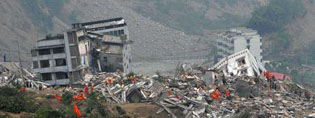Haiti (MNN) — One year after a devastating earthquake struck Haiti, MAF (Mission Aviation Fellowship) is still hard at work, providing vital air transportation to fight cholera, enable relief efforts, and aid in the rebuilding of the crippled nation.
"This has been a year of tragedy for Haiti, and MAF has been there from the beginning, standing alongside the Haitian people and doing all we can to improve the situation of the suffering," says John Boyd, MAF president and CEO.
Former President Bill Clinton of the Clinton Bush Haiti Fund recently commended MAF for its vital role in the relief and rebuilding efforts.
"By organizing hundreds of relief flights and delivering thousands of pounds of supplies, you've had a critical impact on Haiti's recovery," said Clinton.
While the earthquake grabbed all the major headlines, 2010 has been a disaster-filled year for the impoverished Caribbean nation. Haiti has also suffered from Hurricane Tomas, a cholera outbreak that has killed an estimated 3,300 people and hospitalized more than 100,000, and political upheaval that has at times stifled Port-au-Prince and surrounding cities.
MAF has been working in Haiti since 1986 and has four aircraft at a permanent base at the Port-au-Prince airport. After the earthquake that crippled Haiti's already weak infrastructure, MAF partnered with some 60 relief agencies, transported medical personnel and aid workers, delivered critical relief supplies, and performed many emergency medical evacuations. Since then, MAF has continued flying provisions such as food, water, and medical supplies — including IV solution — to help combat the country's cholera outbreak.
"We recently flew a medical team and some 900 pounds of IV solution to a hospital in Port-de-Paix that was running short of staff and supplies," says Boyd.
Upon landing, the MAF pilot also drove the medical team and supplies to the hospital, where more than 100 cholera patients were being treated–most of them children under age 12. Because their veins had collapsed due to severe dehydration, traditional IVs could not be used. The doctors taught hospital staff how to administer IVs through the bone marrow, a painful but life-saving treatment. Since beginning the bone marrow procedures, the hospital has drastically reduced the number of deaths.
As a result of the earthquake and subsequent misfortunes that have struck Haiti, the need for MAF services has pushed its Haiti operations to full capacity. The ministry serves 16 airstrips and has added an additional plane to its fleet to meet the demand.
While already a challenging place, new obstacles have emerged. Many Haitians are disabled, having lost limbs after being trapped under the rubble of collapsed buildings. Haitian doctors are struggling to make a living with the sudden influx of free health care and clinics. And more than one million people remain in tent cities.
"MAF's role has increased exponentially because the infrastructure has been so compromised," Boyd says. "MAF's services have become paramount to the rebuilding process of Haiti. Every week, we are called upon to transport work teams and building supplies, or special equipment like water purification systems."
MAF Haiti staff recently had an opportunity to minister in a different way by building homes for families whose houses collapsed in the earthquake. Through gifts from generous donors, MAF purchased 26 pre-fabricated structures and built them on the existing foundations. Though small by U.S. standards, the houses are well-anchored, sturdy, and much appreciated by the families that were previously living in tents.
Founded in 1945, MAF (www.maf.org) is a Christian ministry organization which transports missionaries, medical personnel and supplies, performs disaster relief work, and conducts emergency medical evacuations in remote areas. In 2010, MAF flew 94,961 passengers and 9.2 million pounds of cargo on 33,365 flights, enabling the work of more than 1,000 mission and relief organizations. MAF also provides distance learning services, as well as telecommunication services such as satellite Internet access, high-frequency radios, electronic mail and other wireless systems.


